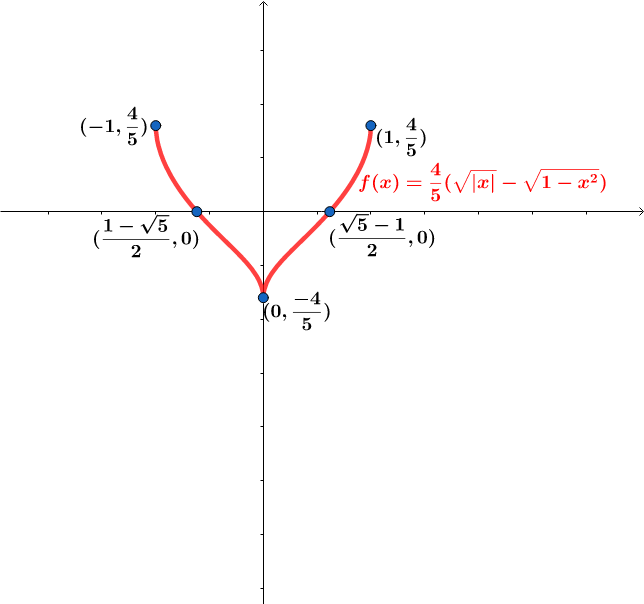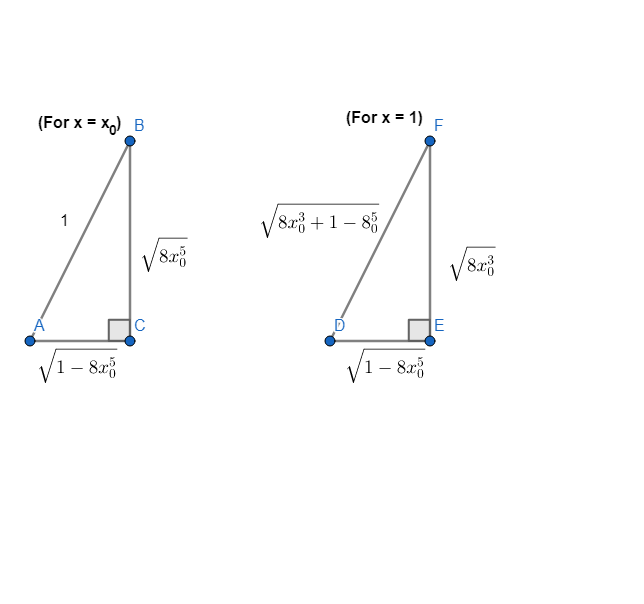Area between Conic and a Curve

Find the conic that intersects the curve at the five points above.
Find the region bounded by the conic and the curve to six decimal places.
The answer is 0.300534.
This section requires Javascript.
You are seeing this because something didn't load right. We suggest you, (a) try
refreshing the page, (b) enabling javascript if it is disabled on your browser and,
finally, (c)
loading the
non-javascript version of this page
. We're sorry about the hassle.
To show the conic is a hyperbola.
Using the point ( 1 , 5 4 ) we obtain (1): a + 2 5 1 6 b + c + 5 4 d = − 1
Using the point ( 0 , 5 − 4 ) we obtain (2): 2 5 1 6 b − 5 4 d = − 1
Using the point ( 2 5 − 1 , 0 ) we obtain (3): ( 2 5 − 1 ) 2 a − 2 5 − 1 c = − 1
Using the point ( − 2 5 − 1 , 0 ) we obtain (4): ( 2 5 − 1 ) 2 a − 2 5 − 1 c = − 1
Using the point ( − 1 , 5 4 ) we obtain (5): a + 2 5 1 6 b − c + 5 4 d = − 1
(3) and (4) ⟹ a = − ( 5 − 1 2 ) 2 and c = 0 ⟹
2 5 1 6 b + 5 4 d = 5 − 1 2
2 5 1 6 b − 5 4 d = − 1
⟹ b = 3 2 2 5 ( 5 − 1 3 − 5 ) = 3 2 2 5 ( 2 5 − 1 ) and d = 8 5 ( 5 − 1 2 ) 2
Letting x 0 = 2 5 − 1 ⟹ a = x 0 2 − 1 , b = 3 2 2 5 x 0 , c = 0 and d = 8 5 ( x 0 2 1 ) ⟹
2 5 x 0 3 y 2 − 3 2 x 2 + 2 0 y = − 3 2 x 0 2 ⟹ 2 5 x 0 3 ( y + 5 x 0 3 2 ) 2 − 3 2 x 2 = x 3 4 − 3 2 x 0 5 which is a hyperbola.
To find the desired area we need to solve for y = g ( x ) .
Solving for y we obtain: y = ( 5 x 0 3 2 ) ( 8 x 0 3 x 2 + 1 − 8 x 0 5 − 1 ) , where y > = 5 − 4 .
Using the symmetry about the y axis let y = g ( x ) and f ( x ) = 5 4 ( x − 1 − x 2 ) .
Let A 1 = ∫ x 0 1 g ( x ) − f ( x ) d x and A 2 = ∫ 0 x 0 f ( x ) − g ( x ) d x so that the desired area A = 2 ( A 1 + A 2 ) .
For A 1 :
For A ∗ = ∫ x 0 1 g ( x ) :
Let 8 x 0 3 x = 1 − 8 x 0 5 tan ( θ ) ⟹ d x = 8 x 0 3 1 − 8 x 0 5 
⟹ A ∗ = ∫ x 0 1 g ( x ) d x = 5 x 0 3 2 ∗ ( 8 x 0 3 1 − 8 x 0 5 ∫ θ 1 θ 2 sec 3 ( θ ) d θ − ∫ x 0 1 d x )
Using integration by parts and evaluating the integral and simplifying we obtain:
A ∗ = 5 x 0 3 2 ( 2 8 x 0 3 + 1 − 8 x 0 5 + 2 1 x 0 − 1 + ( 2 8 x 0 3 1 − 8 x 0 5 ) ∗ ln ∣ 1 + 8 x 0 5 8 x 0 3 + 1 − 8 x 0 5 + 8 x 0 3 ∣ )
For A ∗ ∗ = 5 4 ∫ x 0 1 ( 1 − x 2 − x ) d x Let x = sin ( θ ) ⟹ d x = cos ( θ ) ⟹
A ∗ ∗ = 5 4 ( 4 π − 2 1 arcsin ( x 0 ) − 2 1 x 0 1 − x 0 2 + 3 2 x 0 2 3 − 3 2 )
A 1 = A ∗ + A ∗ ∗ ≈ . 0 4 3 7 4 1
Similarly For A 2 = = ∫ 0 x 0 f ( x ) − g ( x ) d x we obtain:
A 2 = 5 4 ( 3 2 x 0 2 3 − 2 1 arcsin ( x 0 ) − 2 1 x 0 1 − x 2 ) − 5 x 0 3 2 ( 2 − x 0 + ( 2 8 x 0 3 1 − 8 x 0 5 ) ln ∣ 1 − 8 x 0 5 1 + 8 x 0 5 ∣ ) ≈ . 1 0 6 5 2 6
∴ The desired area is A = 2 ( A 1 + A 2 ) = . 3 0 0 5 3 4 .
Note: Using the conic a x 2 + b x y + c y 2 + d x + e y = − 1 with the points above gives us:
a + 5 4 b + 2 5 1 6 c + d + 5 4 e = − 1
a − 5 4 b + 2 5 1 6 c − d + 5 4 e = − 1
( 2 5 − 1 ) 2 a + 2 5 − 1 d = − 1
( 2 5 − 1 ) 2 a − 2 5 − 1 d = − 1
2 5 1 6 c − 5 4 e = − 1
Again, letting x 0 = 2 5 − 1 and solving the system we obtain:
a = x 0 2 − 1 , d = 0 , c = 3 2 2 5 x 0 , e = 8 5 ( x 0 2 1 ) and b = 0 which results in the same hyperbola we had above with a zero coefficient for the x y term.